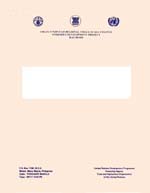
Consultant (Aquaculture)
ASEAN/UNDP/FAO Regional Small-Scale Coastal Fisheries Development Project
Manila, Philippines
November 1986
| Work Plan Implementation (Working Paper) | ASEAN/SF/86/WP/1 |
| November 1986 | REGIONAL |
 | Seafarming as Alternative to Small-Scale Fishing in ASEAN Region H. R. RabanalConsultant (Aquaculture) ASEAN/UNDP/FAO Regional Small-Scale Coastal Fisheries Development Project |
NOTICE OF COPYRIGHT
The copyright in this publication is vested in the Food and Agriculture Organization of the United Nations. This publication may not be reproduced, in whole or in part, by any method or process, without written permission from the copyright holder. Applications for such permission with a statement of the purpose and extent of the reproduction desired, should be made through and addressed to the Chief Technical Adviser, ASEAN/UNDP/FAO Regional Small-Scale Coastal Fisheries Development Project, P.O. Box 1184, MCC, Makati, Metro Manila or 3rd Floor, Arcadia Building, 860 Quezon Avenue, Quezon City, Philippines.
ABSTRACT
Fisheries is important in the ASEAN Region with capture fisheries and aquaculture as its two major sectors of production. Seafarming or mariculture is a subsector of aquaculture involving the culture of fishery resources from the seashoreline to the open sea as distinguished from inland aquaculture (freshwater or brackish) which is land-based.
Worldwide survey including that in ASEAN showed that coastal fishing communities are generally in a depressed economic state brought about by increase in the number of fishermen beyond the capacity of the available resources, use of more efficient or harmful methods of capture and/or major environmental changes (pollution, urbanization, industrialization, etc.) that have adverse effects on the fishery resources.
There is consensus among ASEAN governments to exert concerted efforts to uplift the economic condition of the large number of coastal subsistence fishermen in the region. Seafarming appears to be the most accessible and suitable means to contain this problem. Fortunately there are some established mariculture practices in specific areas in the region like the culture of molluscs (mussels, oysters, cockles) and seaweeds (Eucheuma) in open waters and netcage culture of marine finfish. Other aspects like crab culture and use of other finfish species like snappers and carangids for rearing in netcages, and the culture of other seaweeds like the agarophytes and edible seaweeds are undergoing development. Supportive services like production of seed stocks through hatcheries are also being looked into and the training of manpower is continuing.
An assessment, through actual survey and from published reports was made of the status of seafarming in each country in ASEAN. An attempt is done to identify mariculture projects/activities and the suitable sites where each may be done in the different countries in the region. Project ideas specifically for each country or a specific region in each country are put forward. These may serve, for each country, as material in the formulation of country programmes and can be referred to in requests for assistance from prospective donor agencies.
Hyperlinks to non-FAO Internet sites do not imply any official endorsement of or responsibility for the opinions, ideas, data or products presented at these locations, or guarantee the validity of the information provided. The sole purpose of links to non-FAO sites is to indicate further information available on related topics.
This electronic document has been scanned using optical character recognition (OCR) software. FAO declines all responsibility for any discrepancies that may exist between the present document and its original printed version.
3. STATUS OF SEAFARMING IN THE REGION
3.1.2 Aquaculture especially seafarming
3.2.1 Technical assistance for development
3.2.2 Netcage culture of marine fish
3.4.1 Aspects of mariculture development
3.4.2 The small-scale fisherman and constraints to seafarming development
3.6.1 Mariculture development and assistance
3.6.2 Fish seed production and other development needs
4.2 Proposals for projects and programme
5. SUMMARY AND RECOMMENDATIONS
6. SELECTED BIBLIOGRAPHY IN SEAFARMING AND SMALL-SCALE FISHING IN ASEAN
Table 1. Data on area and population of ASEAN countries
2. Fisheries production in ASEAN, by sector
3. Aquaculture production in ASEAN countries in mt (1983/1984/1985)
4. Status of seafarming in ASEAN
5. Data on number of fishermen in ASEAN (1983/1984/1985)
6. Fisheries production in Brunei, 1973–1985
7. Production of cultured cockle in Malaysia, 1976–1983
8. Production from netcage culture of marine finfish in Malaysia, 1976–1983
9. Length of coastline of Thailand, by region and province
Appendix 1 Terms of reference and itinerary of travel
3 Potential species and sites for netcage culture of marine finfish in Indonesia
4 Potential sites for the culture of marine molluscs in Indonesia
5 Potential sites for seaweed culture in Indonesia
6 Summaries of proposed seafarming projects/activities in ASEAN
Figure 1 The ASEAN countries and adjacent waters
2 Location map of Brunei showing coastal areas
3 Map of Indonesia showing location of the national seafarming development center, subregional centers and pilot farms
4 Peninsular Malaysia showing coastal profile
5 Sabah and Sarawak states in East Malaysia
6 The Philippines and adjacent waters showing statistical fishing waters
7 Singapore showing coastal profile
8 Thailand showing coastal provinces and adjacent countries